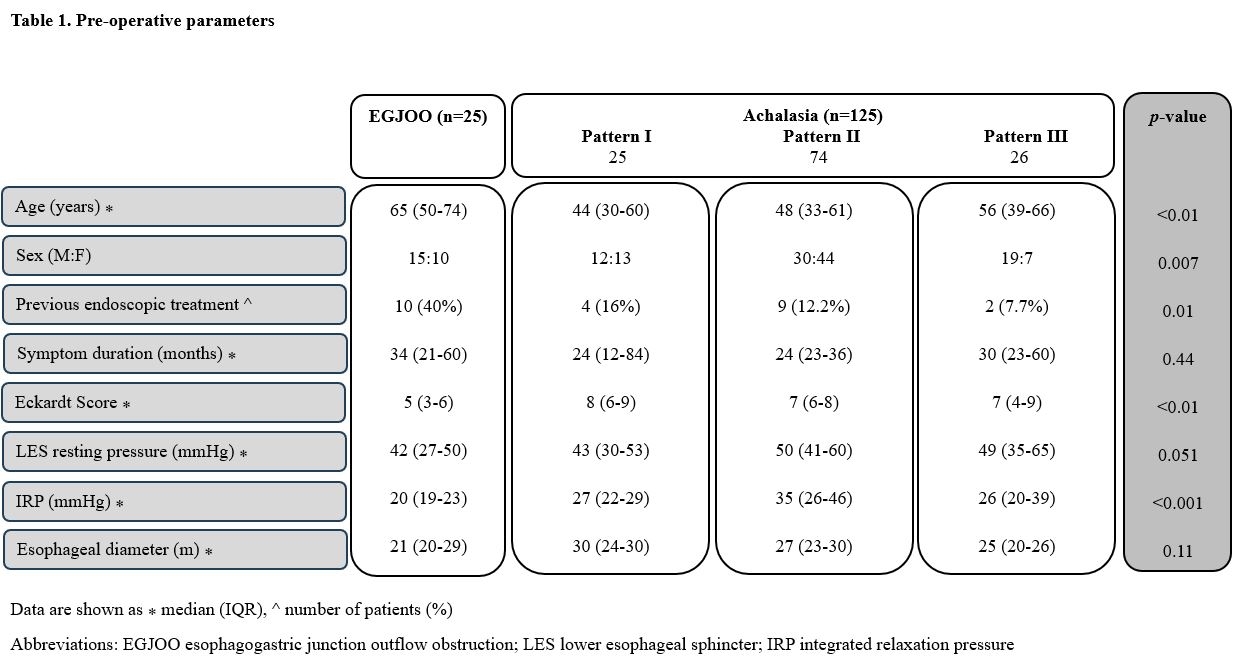Back to 2024 Abstracts
LONG-TERM RESULTS OF LAPAROSCOPIC HELLER-DOR FOR ESOPHAGO-GASTRIC JUNCTION OUTFLOW OBSTRUCTION: A PROSPECTIVE CONTROLLED TRIAL
Francesca Forattini
*, Luca Provenzano, Mario Costantini, Giulia Nezi, Giovanni Capovilla, Andrea Costantini, Lucia Moletta, Loredana Nicoletti, Michele Valmasoni, Renato Salvador
Department of Surgical, Oncological and Gastroenterological Sciences,, Universita degli Studi di Padova, Padova, Veneto, Italy
BACKGROUND: The gold-standard treatment for esophago-gastric junction outflow obstruction (EGJOO) is still debated. Currently, the management of this motility disorder reflects the experience gained with esophageal achalasia, for which Laparoscopic Heller-Dor (LHD) has been proven to be an effective long-term treatment. However, prospective data comparing long-term results of LHD for these two motility disorders are still lacking. The aim of this prospective, controlled study was to assess the 5-year follow-up of laparoscopic Heller-Dor (LHD) in patients with EGJOO, compared with radiological stage I achalasia patients (ACH).
METHODS: Patients with diagnosis of idiopathic EGJOO (i.e. not postoperative or associated to other esophageal condition), referred for dysphagia or food regurgitation, and radiological stage I achalasia (subgrouped by manometric pattern I, II & III), treated with LHD, were enrolled to the study and then followed prospectively for 5 years.
During the follow-up patients were evaluated with Eckard score (ES), Barium-swallow X-ray, High Resolution Manometry (HRM), 24 hour pH-monitoring and Upper-Gastrointestinal endoscopy. The primary outcome was therapeutic success (presence of ES ≤3 or no additional treatment) at the 5-year follow-up assessment. The secondary outcomes included the postoperative IRP and the evidence of gastro-oesophageal reflux.
RESULTS: The study involved 150 patients: 25 in the EGJOO group and 125 in the ACH group (25 pattern I, 74 pattern II, and 26 pattern III). The patients' demographic and clinical parameters are summarized in Table 1. After 5 years, there was no significant difference in success rate: 92% in the EGJOO, 88% in achalasia pattern I, 91.9% in pattern II and 92.3% in pattern III (p=0.95). The ES and all the HRM parameters were similar in the four groups. The screening endoscopy showed no differences in the presence of esophagitis in the four groups (p=0.08). The 24-hours pH-monitoring showed a similar postoperative abnormal acid exposure in all groups (p=0.87) (Table 2).
CONCLUSIONS: This is the first long-term comparative study based on prospective data collection to assess the outcome of LHD in patients with EGJOO. After at least 5 years of follow-up, Laparoscopic Heller-Dor has a comparable success rate in both EGJOO and achalasia patients. Based on these data, we conclude that LHD can be proposed as a first-line treatment for symptomatic EGJOO, provided the diagnosis is accurate.


Back to 2024 Abstracts